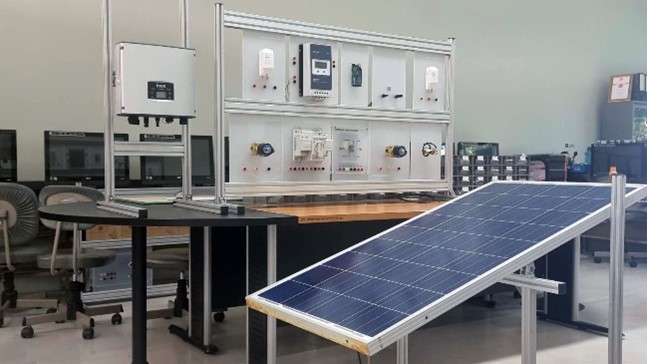การออกแบบสภาพแวดล้อมการเรียนรู้เพื่อพัฒนานวัตกรรมเพื่อชุมชน
Main Article Content
บทคัดย่อ
การวิจัยนี้มีวัตถุประสงค์ เพื่อออกแบบสภาพแวดล้อมการเรียนรู้เพื่อพัฒนานวัตกรรมเพื่อชุมชน และเพื่อวิเคราะห์สภาพแวดล้อมการเรียนรู้ที่ส่งผลต่อการเรียนรู้เพื่อพัฒนนวัตกรรมเพื่อชุมชุมและทัศนคติการเรียนรู้ของผู้เรียน การดำเนินการวิจัย ประกอบด้วย การออกแบบและสร้างชุดทดลองสำหรับการพัฒนาทักษะการพัฒนานวัตกรรมเพื่อชุมชน การออกแบบและปรับปรุงแผนผังห้องเรียนและที่นั่งในห้องปฏิบัติการ และการออกแบบสภาพแวดล้อมทางกายภาพ กลุ่มตัวอย่างในการวิจัยเป็นนักศึกษา ระดับปริญญาตรี สาขาวิศวกรรมไฟฟ้า มหาวิทยาลัยเทคโนโลยีราชมงคลศรีวิชัย เป็นกลุ่มตัวอย่างตามสภาพจริงใช้วิธีการเลือกแบบเจาะจง จำนวน 32 คน การเก็บรวบรวมข้อมูลโดยการให้ผู้เรียนทำแบบสอบถามหลังผ่านการเรียนการสอนภายใต้สภาพแวดล้อมการเรียนรู้ที่สร้างขึ้น การวิเคราะห์ผลการวิจัยใช้การถดถอยพหุคูณ (Multiple Regression Analysis) เพื่อวิเคราะห์หาตัวแปรของสภาพแวดล้อมการเรียนรู้ที่ส่งผลต่อการส่งเสริมการเรียนรู้เพื่อการพัฒนานวัตกรรมเพื่อชุมชุม ผลการวิจัยสรุปได้ว่า ความสอดคล้องกับกิจกรรมการเรียนการสอน ความสามารถในการกระตุ้นความสนใจในการเรียนรู้ของผู้เรียนของชุดทดลอง เป็นปัจจัยที่ส่งผลต่อความสามารถในการส่งเสริมการเรียนรู้เพื่อพัฒนานวัตกรรมของผู้เรียน และปัจจัยเกี่ยวกับความเหมาะสมของชุดทดลอง และการจัดวางของการออกแบบสภาพแวดล้อมการเรียนรู้ ส่งผลต่อทัศนคติการเรียนรู้ของผู้เรียนในการออกแบบและพัฒนานวัตกรรมเพื่อชุมชน
Article Details

อนุญาตภายใต้เงื่อนไข Creative Commons Attribution-NonCommercial-NoDerivatives 4.0 International License.
เอกสารอ้างอิง
มารุต พัฒผล. (2562). การแก้ปัญหาเชิงนวัตกรรม. กรุงเทพมหานคร: ศูนย์ผู้นำนวัตกรรมหลักสูตรและการเรียนรู้.
Abdulloh, W., & Niemted, W. (2020). Arrangement of Learning Environment to Promote Learning Skills in the 21st Century “Concept Theory and Practice”. Princess of Naradhiwas University Journal of Humanities and Social Sciences, 7(2), 227-246.
Ahmad, C. N. C., Ching, W. C., Yahaya, A., & Abdullah, M. F. N. L. (2015). Relationship between Constructivist Learning Environments and Educational Facility in Science Classrooms. Procedia - Social and Behavioral Sciences, 191, 1952-1957. doi:https://doi.org/10.1016/j.sbspro.2015.04.672
Alfred, M., Neyens, D. M., & Gramopadhye, A. K. (2018). Comparing learning outcomes in physical and simulated learning environments. International Journal of Industrial Ergonomics, 68, 110-117. doi:https://doi.org/10.1016/j.ergon.2018.07.002
Alhefnawi, M. A. M. (2021). Assessing the efficacy of online handouts and active lectures in learning outcomes at the engineering undergraduate level. Ain Shams Engineering Journal, 12(3), 3375-3380. doi:https://doi.org/10.1016/j.asej.2021.02.012
Alía, C., Ocaña, R., Caja, J., Maresca, P., Moreno-Díaz, C., & Narbón, J. J. (2019). Use of open manufacturing laboratories (Fab Labs) as a new trend in engineering education. Procedia Manufacturing, 41, 938-943. doi:https://doi.org/10.1016/j.promfg.2019.10.018
Alsadoon, E., Alkhawajah, A., & Suhaim, A. B. (2022). Effects of a gamified learning environment on students’ achievement, motivations, and satisfaction. Heliyon, 8(8), e10249. doi:https://doi.org/10.1016/j.heliyon.2022.e10249
Castelló, E., Santiviago, C., Ferreira, J., Coniglio, R., Budelli, E., Larnaudie, V., . . . López, I. (2023). Towards competency-based education in the chemical engineering undergraduate program in Uruguay: Three examples of integrating essential skills. Education for Chemical Engineers, 44, 54-62. doi:https://doi.org/10.1016/j.ece.2023.05.004
Chanthana Papattha, & Namon Jeerangsuwan. (2013). Virtual Learning Environment Creative Education Creative Thinking Skills. RMUTP Research Journal, 7(2), 154-167. doi:10.14456/jrmutp.2013.14
Chulalak Soraphand, & Therapathara Kulophas. (2019). Management Strategies for Higher Education Institutions Under the Royal Thai Navy According to the Concept of Capacity Building for Innovation Research and Development. Journal of Education Studies, 47(Suppl. 1), 95-117.
Dada, D., Laseinde, O. T., & Tartibu, L. (2023). Student-Centered Learning Tool for Cognitive Enhancement in the Learning Environment. Procedia Computer Science, 217, 507-512. doi:https://doi.org/10.1016/j.procs.2022.12.246
Dewey, J. (1938). Experience and Education. New York: Macmillan.
Du, J., Wang, X., Geng, M., & Huang, R. (2017, 3-7 July 2017). Manage Learning Space to Improve Learning Experience: Case Study in Beijing Normal University on Classroom Layout. Paper presented at the 2017 IEEE 17th International Conference on Advanced Learning Technologies (ICALT).
Feoktistov, D., Sharapova, I., Orlova, E., & Ponomarev, K. (2015). Experimental Research of Wetting and Drop Evaporation Processes on a Heated Substrate as a Method for Research Skills Development for Heat and Power Engineering Students. Procedia - Social and Behavioral Sciences, 206, 307-314. doi:https://doi.org/10.1016/j.sbspro.2015.10.056
Gremmen, M. C., van den Berg, Y. H. M., Segers, E., & Cillessen, A. H. N. (2016). Considerations for classroom seating arrangements and the role of teacher characteristics and beliefs. Social Psychology of Education, 19(4), 749-774. doi:10.1007/s11218-016-9353-y
Haron, Z., Mohammad, S., Sam, A. R., MushairryMustaffar, & JamaludinMohdYatim. (2013). The Implementation of an Open-ended Experiment in the Civil Engineering Laboratory. Procedia - Social and Behavioral Sciences, 102, 548-559. doi:https://doi.org/10.1016/j.sbspro.2013.10.771
Knox, P., Simpson, A., Yang, J., & Maltese, A. (2022). Exploring caregiver influence on child creativity and innovation in an out-of-school engineering program. Thinking Skills and Creativity, 45, 101064. doi:https://doi.org/10.1016/j.tsc.2022.101064
Lobczowski, N. G., Lyons, K., Greene, J. A., & McLaughlin, J. E. (2021). Socially shared metacognition in a project-based learning environment: A comparative case study. Learning, Culture and Social Interaction, 30, 100543. doi:https://doi.org/10.1016/j.lcsi.2021.100543
Niti Iamchuen, Phummipat Oonban, Wannutcha Thepwong, & Thidapath Anucharn. (2022). Geo-Informatics Technology for Management of Thai Peafowl Conservation Areasin the area of Wiang Lo Wildlife Sanctuary, Phayao Province. The Journal of Spatial Innovation Development (JSID), 3(2), 1-17.
Nöhring, F., Rieger, M., Erohin, O., Deuse, J., & Kuhlenkötter, B. (2015). An Interdisciplinary and Hands-on Learning Approach for Industrial Assembly Systems. Procedia CIRP, 32, 109-114. doi:https://doi.org/10.1016/j.procir.2015.02.112
Norazman, N., Ismail, A., Nor Haslina, J. a., Khoiry, M. A., & Che-Ani, A. (2019). A REVIEW OF SEATING ARRANGEMENTS TOWARDS THE 21st CENTURY CLASSROOM APPROACH IN SCHOOLS. Malaysian Journal of Sustainable Environment, 6, 21. doi:10.24191/myse.v6i2.8684
Ocampo-López, C., Forero-Gaviria, L., Gañán-Rojo, P., Martínez-Arboleda, J., & Castrillón-Hernández, F. (2023). Incorporating process safety into a Colombian chemical engineering curriculum: A perception study. Education for Chemical Engineers, 44, 45-53. doi:https://doi.org/10.1016/j.ece.2023.04.004
Office of the National Economic and Social Development Council. (2012). From the Philosophy of Sufficiency Economy into Practice for More Than a Decade. Bangkok Thailand: Office of the National Economic and Social Development Council, Research and Development Institute of Sufficiency Economy Philosophy Foundation: RSEPF, The Crown Property Bureau.
Renard, L. (2019, Dec 19, 2019). 19 Classroom seating arrangements fit for your teaching. Retrieved from https://www.bookwidgets.com/blog/2019/12/19-classroom-seating-arrangements-fit-for-your-teaching
Ripoll, V., Godino-Ojer, M., & Calzada, J. (2023). Development of engineering skills in students of biotechnology: Innovation project “From laboratory to industry”. Education for Chemical Engineers, 43, 37-49. doi:https://doi.org/10.1016/j.ece.2023.01.006
Sascha Bernholt, Knut Neumann, & Peter Nentwig. (2012). Making it Tangible: Learning Outcomes in Science Education: Waxmann Verlag GmbH, Germany.
Smith, J., & Johnson, L. (2023). Strategies for Selection of Instructional Media in Classroom Instruction. International Journal of Research Publication and Reviews, 45(2), 78-92.
UNESCO Institute for Statistics. (2012). A PLACE TO LEARN: LESSONS FROM RESEARCH ON LEARNING ENVIRONMENTS. Canada: UNESCO Institute for Statistics.
Verma, P., & Singh, A. (2014). Multifaceted Impact of Technology on Rural Development. SSRN Electronic Journal. doi:10.2139/ssrn.2461348
Vogel-Heuser, B., Rehberger, S., Gramss, D., & Mayer, F. (2015). Integrating Lab-size Automation Plants into a Web-based E-learning Environment for Teaching C Programming in Teams. IFAC-PapersOnLine, 48(29), 295-300. doi:https://doi.org/10.1016/j.ifacol.2015.11.251
Watcharaporn Amonsak, Ponglikit Petpon, & Pruet Siribanpitak. (2022). Academic Management Innovation Creating STEM Education Innovators for Application in Real Life Situations. Sukhothai Thammathirat Open University Journal, 15(2).
Ying, W., Mingxuan, L., Qian, Z., Shuxian, Z., Yufang, G., & Kefang, W. (2023). The mediating role of professional commitment between the clinical learning environment and learning engagement of nursing students in clinical practice: A cross-sectional study. Nurse Education Today, 121, 105677. doi:https://doi.org/10.1016/j.nedt.2022.105677


